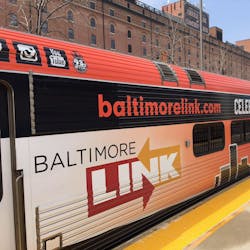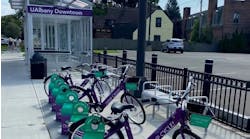The Maryland Transit Administration is a statewide agency and a division of the Maryland Department of Transportation. MTA operates local and commuter buses, light rail, the metro subway, Maryland Area Regional Commuter rail service, paratransit service, and manages the Taxi Access system. MTA also directs funding and statewide assistance to locally operated transit systems throughout the state.
There’s been a heavy emphasis on social media, in part because of the age of a lot of the MTA’s customers. With so many school children, they have a heavy presence where the kids are, on Snapchat and Instagram.
With BaltimoreLink, a complete overhaul and rebranding of MTA’s core bus system coming in June 2017, they’re messaging a route every single day for several months: how it’s changing, from what the current alignment looks like to what it will look like in the new system.
They’ve also been letting customers know about the Information Bus that’s been going around. It rides every single route and if people jump on that bus, they get a free ride.
The MTA also has its own FM radio station that launched in 2016, 93.5 FM. It’s in Baltimore and in the D.C. area, as well as other parts of Maryland. “It’s a fantastic vehicle to constantly let people know about what’s going on,” said Ryan Nawrocki, senior director of communications and marketing.
It was about 15 months out to the launch of BaltimoreLink when Nawrocki came on board at MTA as its senior director of communications and marketing. At the time there wasn’t an adequate presence on social media so they quickly ramped up the social media presence, going from four platforms to 12. They also went to more consistent posting, to at least three posts every day, including more visuals and video.
To increase their presence, they also started utilizing paid content on several platforms. Nawrocki said, “The way that Facebook and a lot of it is structured, the model there is they want you to buy ads.
“You want to put your content out in front of as many people as possible; you have to have paid campaigns running,” he said. As a result, in the past year they’ve quadrupled the audience on Facebook and doubled the audience on Twitter.
There’s a team of three that are primarily responsible for social media engagement, responding to the comments and questions. “That’s why Ryan’s up until 2 in the morning,” Administrator and CEO Paul Comfort joked. “I’m up pretty late,” he agreed.
As some of the platforms, like Facebook, recognize auto replies that count against the algorithm of feeding your posts to people, they don’t ever use complete automation. Though there is a level of automation with some of it, such as some of the rider alerts will automatically populate to the Twitter feed.
Speaking of automated messaging, Nawrocki said, “a lot of that automated stuff, it’s good, it does serve a purpose for a certain audience, but it doesn’t really allow you to grow your audience.”
Making social media more customer friendly as opposed to passive engagement, is the focus. “Not everyone is doing that in the industry,” he said. “If they see there’s a more interactive, more engaged presence, other people will come to your page.”


